The AMD Radeon R9 Fury X Review: Aiming For the Top
by Ryan Smith on July 2, 2015 11:15 AM ESTFiji’s Architecture: The Grandest of GCN 1.2
We’ll start off our in-depth look at the R9 Fury X with a look at the Fiji GPU underneath.
Like the Hawaii GPU before it, from a release standpoint Fiji is not really the pathfinder chip for its architecture, but rather it’s the largest version of it. Fiji itself is based on what we unofficially call Graphics Core Next 1.2 (aka GEN3), and ignoring HBM for the moment, Fiji incorporates a few smaller changes but otherwise remaining nearly identical to the previous GCN 1.2 chips. The pathfinder for GCN 1.2 in turn was Tonga, which was released back in September of 2014 as the Radeon R9 285.
So what does GCN 1.2 bring to the table over Hawaii and the other GCN 1.1 chips? Certainly the most well-known and marquee GCN 1.2 feature is AMD’s latest generation delta color compression technology. Tied in to Fiji’s ROPs, delta color compression augments AMD’s existing color compression capabilities with additional compression modes that are based around the patterns of pixels within a tile and the differences between them (i.e. the delta), increasing how frequently and by how much frame buffers (and RTs) can be compressed.
Frame buffer operations are among the most bandwidth intensive in a GPU – it’s a lot of pixels that need to be resolved and written to a buffer – so reducing the amount of memory bandwidth these operations draw on can significantly increase the effective memory bandwidth of a GPU. In AMD’s case, GCN 1.2’s delta color compression improvements are designed to deliver up to a 40% increase in memory bandwidth efficiency, with individual tiles being compressible at up to an 8:1 ratio. Overall, while the lossless nature of this compression means that the exact amount of compression taking place changes frame by frame, tile by tile, it is at the end of the day one of the most significant improvements to GCN 1.2. For Radeon R9 285 it allowed AMD to deliver similar memory performance on a 256-bit memory bus (33% smaller than R9 280’s), and for Fiji it goes hand-in-hand with HBM to give Fiji an immense amount of effective memory bandwidth to play with.
Moving on, AMD has also made some changes under the hood at the ALU/shader level for GCN 1.2. Many of these changes are primarily for AMD’s Carrizo APU, where task scheduling improvements go hand-in-hand with the AMD’s Heterogeneous System Architecture initiative and deliver improvements to allow the CPU and GPU to more easily deliver work to each other. Similarly, 16-bit instructions are intended to save on power consumption in mobile devices that use lower precision math for basic rendering.
More applicable to Fiji and its derivatives are the improvements to data-parallel processing. GCN 1.2 now has the ability for data to be shared between SIMD lanes in a limited fashion, beyond existing swizzling and other data organizations methods. This is one of those low-level tweaks I’m actually a bit surprised AMD even mentioned (though I’m glad they did) as it’s a little tweak that’s going to be very algorithm specific. For non-programmers there’s not much to see, but for programmers – particularly OpenCL programmers – this will enable newer, more efficient algorithms where when the nature of the work requires working with data in adjacent lanes.
But for gamers, perhaps the most significant architectural improvement to GCN 1.2 and thereby Fiji are the changes made to tessellation and geometry processing. There is no single silver bullet here – after going with a 4-wide geometry front-end in Hawaii, AMD hasn’t changed it for Tonga or Fiji – but AMD has put in quite a bit of effort in to improving how geometry data moves around within the chip and how it’s used, on the basis that at this point the limitations aren’t in raw geometry performance, but rather the difficulties in achieving that performance.
Much of this effort has been invested in better handling small geometry, whether it’s large quantities of small batches, or even small quantities of small batches. The inclusion of small instance caching, for example, allows the GPU to better keep small batches of draw calls in cache, allowing them to be referenced and/or reused in the future without having to go to off-cache memory. Similarly, AMD can now store certain cases of vertex inputs for the geometry shader in shared memory, which like small instance caching allows for processing to take place more frequently on-chip, improving performance and cutting down on DRAM traffic.
More specific to Fiji’s incarnation of GCN is how distribution is handled. Load balancing and distribution among the geometry frontends is improved overall, including some low-level optimizations to how primitives generated from tessellation are distributed. Generally speaking distribution is a means to improve performance by removing bottlenecks, however AMD is now catching a specific edge case where small amplification factors don’t generate a lot of primitives, and in those cases they’re now skipping distribution since the gains are minimal, and more likely than not the cost from the bus traffic is greater than the benefits of distribution.
Finally, AMD has also expanded the vertex reuse window on GCN 1.2. As in the general case of reuse windows, the vertex reuse window is a cache of sorts for vertex data, allowing old results to be held in waiting in case they are needed again (as is often the cases in graphics). Though they aren’t telling us just how large the window now is, GCN 1.2 now features a larger window, which increases the hit rate for vertex data and as a result further edges geometry performance up since that data no longer needs to be regenerated.
As with our R9 285 review, I took the time to quickly run TessMark across the x8/x16/x32/x64 tessellation factors just to see how tessellation and geometry performance scales on AMD’s cards as the tessellation factor increases. Keeping in mind that all of the parts here have a 4-wide geometry front-end, the R9 285, R9 290X, and R9 Fury X all have the same geometry throughput on paper, give or take 10% for clockspeeds. What we find is that Fury X shows significant performance improvements at all levels, beating not only the Hawaii based R9 290X, but even the Tonga based R9 285. Tessellation performance is consistently 33% ahead of the R9 290X, while against Tonga it’s anywhere between a 33% lead at high factors to a 130% lead at low tessellation factors, showing the influence of AMD’s changes to how tessellation is handled with low factors.


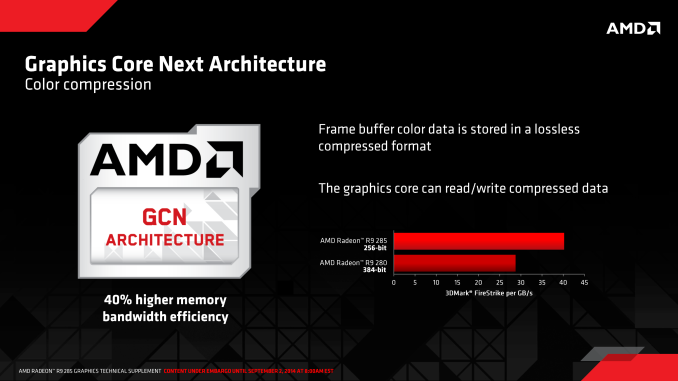
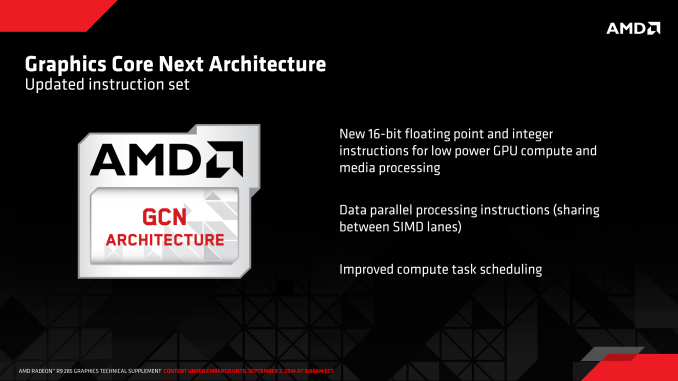
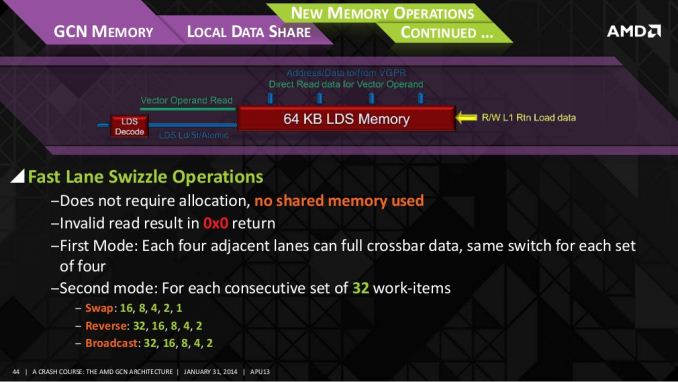
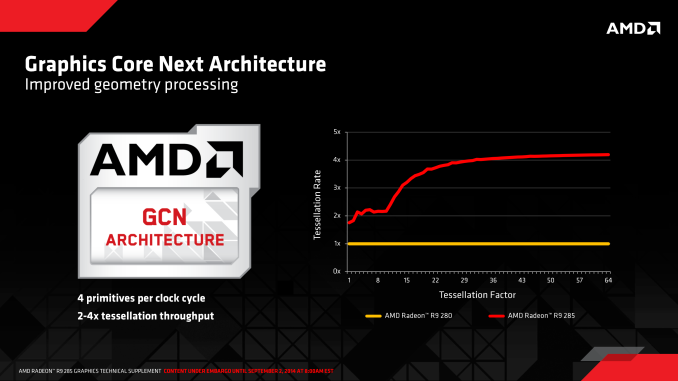
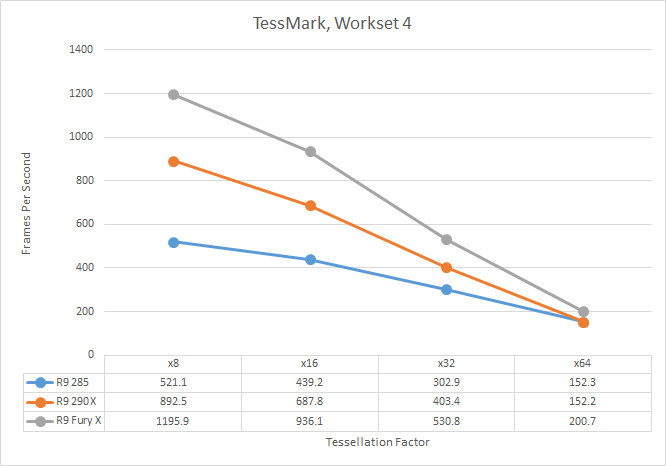








458 Comments
View All Comments
testbug00 - Sunday, July 5, 2015 - link
You don't need architecture improvements to use DX12/Vulkan/etc. The APIs merely allow you to implement them over DX11 if you choose to. You can write a DX12 game without optimizing for any GPUs (although, not doing so for GCN given consoles are GCN would be a tad silly).If developers are aiming to put low level stuff in whenever they can than the issue becomes that due to AMD's "GCN everywhere" approach developers may just start coding for PS4, porting that code to Xbox DX12 and than porting that to PC with higher textures/better shadows/effects. In which Nvidia could take massive performance deficites to AMD due to not getting the same amount of extra performance from DX12.
Don't see that happening in the next 5 years. At least, not with most games that are console+PC and need huge performance. You may see it in a lot of Indie/small studio cross platform games however.
RG1975 - Thursday, July 2, 2015 - link
AMD is getting there but, they still have a little bit to go to bring us a new "9700 Pro". That card devastated all Nvidia cards back then. That's what I'm waiting for to come from AMD before I switch back.Thatguy97 - Thursday, July 2, 2015 - link
would you say amd is now the "geforce fx 5800"piroroadkill - Thursday, July 2, 2015 - link
Everyone who bought a Geforce FX card should feel bad, because the AMD offerings were massively better. But now AMD is close to NVIDIA, it's still time to rag on AMD, huh?That said, of course if I had $650 to spend, you bet your ass I'd buy a 980 Ti.
Thatguy97 - Thursday, July 2, 2015 - link
oh believe me i remember they felt bad lol but im not ragging on amd but nvidia stole their thunder with the 980 tiKateH - Thursday, July 2, 2015 - link
C'mon, Fury isn't even close to the Geforce FX level of fail. It's really hard to overstate how bad the FX5800 was, compared to the Radeon 9700 and even the Geforce 4600Ti.The Fury X wins some 4K benchmarks, the 980Ti wins some. The 980Ti uses a bit less power but the Fury X is cooler and quieter.
Geforce FX level of fail would be if the Fury X was released 3 months from now to go up against the 980Ti with 390X levels of performance and an air cooler.
Thatguy97 - Thursday, July 2, 2015 - link
To be fair the 5950 ultra was actually decentMorawka - Thursday, July 2, 2015 - link
your understating nvidia's scores.. the won 90% of all benchmarks, not just "some". a full 120W more power under furmark load and they are using HBM!!looncraz - Thursday, July 2, 2015 - link
Furmark power load means nothing, it is just a good way to stress test and see how much power the GPU is capable of pulling in a worst-case scenario and how it behaves in that scenario.While gaming, the difference is miniscule and no one will care one bit.
Also, they didn't win 90% of the benchmarks at 4K, though they certainly did at 1440. However, the real world isn't that simple. A 10% performance difference in GPUs may as well be zero difference, there are pretty much no game features which only require a 10% higher performance GPU to use... or even 15%.
As for the value argument, I'd say they are about even. The Fury X will run cooler and quieter, take up less space, and will undoubtedly improve to parity or beyond the 980Ti in performance with driver updates. For a number of reasons, the Fury X should actually age better, as well. But that really only matters for people who keep their cards for three years or more (which most people usually do). The 980Ti has a RAM capacity advantage and an excellent - and known - overclocking capacity and currently performs unnoticeably better.
I'd also expect two Fury X cards to outperform two 980Ti cards with XFire currently having better scaling than SLI.
chizow - Thursday, July 2, 2015 - link
The differences in minimums aren't miniscule at all, and you also seem to be discounting the fact 980Ti overclocks much better than Fury X. Sure XDMA CF scales better when it works, but AMD has shown time and again, they're completely unreliable for timely CF fixes for popular games to the point CF is clearly a negative for them right now.